
16 Results

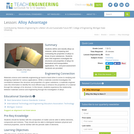
Students define and classify alloys as mixtures, while comparing and contrasting the properties of alloys to those of pure substances. Students learn that engineers investigate the structures and properties of alloys for biomedical and transportation applications. Pre- and post-assessment handouts are provided.
- Subject:
- Chemistry
- Physical Science
- Material Type:
- Lesson
- Provider:
- TeachEngineering
- Author:
- Janelle Orange
- Date Added:
- 02/03/2017

Biology is designed for multi-semester biology courses for science majors. It is grounded on an evolutionary basis and includes exciting features that highlight careers in the biological sciences and everyday applications of the concepts at hand. To meet the needs of today’s instructors and students, some content has been strategically condensed while maintaining the overall scope and coverage of traditional texts for this course. Instructors can customize the book, adapting it to the approach that works best in their classroom. Biology also includes an innovative art program that incorporates critical thinking and clicker questions to help students understand—and apply—key concepts.
- Subject:
- Biology
- Life Science
- Material Type:
- Full Course
- Provider:
- Rice University
- Provider Set:
- OpenStax College
- Date Added:
- 08/22/2012
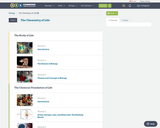
- Subject:
- Biology
- Life Science
- Material Type:
- Unit of Study
- Provider:
- Rice University
- Provider Set:
- OpenStax College

By the end of this section, you will be able to:Define matter and elementsDescribe the interrelationship between protons, neutrons, and electronsCompare the ways in which electrons can be donated or shared between atomsExplain the ways in which naturally occurring elements combine to create molecules, cells, tissues, organ systems, and organisms
- Subject:
- Applied Science
- Biology
- Life Science
- Material Type:
- Module
- Author:
- Tina B. Jones
- Date Added:
- 08/26/2019

By the end of this section, you will be able to:Define matter and elementsDescribe the interrelationship between protons, neutrons, and electronsCompare the ways in which electrons can be donated or shared between atomsExplain the ways in which naturally occurring elements combine to create molecules, cells, tissues, organ systems, and organisms
- Subject:
- Applied Science
- Biology
- Life Science
- Material Type:
- Module
- Date Added:
- 07/10/2017

- Subject:
- Applied Science
- Biology
- Life Science
- Material Type:
- Module
- Date Added:
- 07/10/2017

This activity demonstrates the spectral nature of light and the identifiable features of the visible light spectrum. Students learn the elemental spectrum, and the ROYGBIV distribution of colors in a rainbow. Students compare the spectra of various light sources, and how to identify specific elements based on their spectral signature.
- Subject:
- Astronomy
- Atmospheric Science
- Chemistry
- Physical Science
- Physics
- Material Type:
- Activity/Lab
- Date Added:
- 09/25/2018
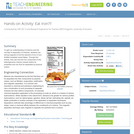
To gain an understanding of mixtures and the concept of separation of mixtures, students use strong magnets to find the element of iron in iron-fortified breakfast cereal flakes. Through this activity, they see how the iron component of this heterogeneous mixture (cereal) retains its properties and can thus be separated by physical means.
- Subject:
- Applied Science
- Chemistry
- Engineering
- Physical Science
- Physics
- Material Type:
- Activity/Lab
- Provider:
- TeachEngineering
- Provider Set:
- TeachEngineering
- Author:
- Parnia Mohammadi
- Roberto Dimaliwat
- Date Added:
- 09/18/2014
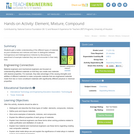
Students gain a better understanding of the different types of materials as pure substances and mixtures and learn to distinguish between homogeneous and heterogeneous mixtures by discussing an assortment of example materials they use and encounter in their daily lives.
- Subject:
- Applied Science
- Chemistry
- Engineering
- Physical Science
- Material Type:
- Activity/Lab
- Provider:
- TeachEngineering
- Provider Set:
- TeachEngineering
- Author:
- Parnia Mohammadi
- Roberto Dimaliwat
- Date Added:
- 09/18/2014
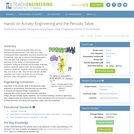
Students learn about the periodic table and how pervasive the elements are in our daily lives. After reviewing the table organization and facts about the first 20 elements, they play an element identification game. They also learn that engineers incorporate these elements into the design of new products and processes. Acting as computer and animation engineers, students creatively express their new knowledge by creating a superhero character based on of the elements they now know so well. They will then pair with another superhero and create a dynamic duo out of the two elements, which will represent a molecule.
- Subject:
- Applied Science
- Chemistry
- Engineering
- Physical Science
- Material Type:
- Activity/Lab
- Provider:
- TeachEngineering
- Provider Set:
- TeachEngineering
- Author:
- Brian Kay
- Denise W. Carlson
- Lauren Cooper
- Malinda Schaefer Zarske
- Megan Podlogar
- Date Added:
- 10/14/2015
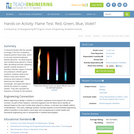
To become familiar with the transfer of energy in the form of quantum, students perform flame tests, which is one way chemical engineers identify elements by observing the color emitted when placed in a flame. After calculating and then preparing specific molarity solutions of strontium chloride, copper II chloride and potassium chloride (good practice!), students observe the distinct colors each solution produces when placed in a flame, determine the visible light wavelength, and apply that data to identify the metal in a mystery solution. They also calculate the frequency of energy for the solutions.
- Subject:
- Applied Science
- Engineering
- Physical Science
- Physics
- Material Type:
- Activity/Lab
- Provider:
- TeachEngineering
- Provider Set:
- TeachEngineering
- Author:
- Amber Spolarich
- Michelle Bell
- Date Added:
- 10/14/2015
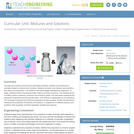
Through three lessons and their four associated activities, students are introduced to concepts related to mixtures and solutions. Students consider how mixtures and solutions and atoms and molecules can influence new technologies developed by engineers. To begin, students explore the fundamentals of atoms and their structures. The building blocks of matter (protons, electrons, neutrons) are covered in detail. The next lesson examines the properties of elements and the periodic table one method of organization for the elements. The concepts of physical and chemical properties are also reviewed. Finally, the last lesson introduces the properties of mixtures and solutions. A comparison of different mixtures and solutions, their properties and their separation qualities are explored.
- Subject:
- Applied Science
- Chemistry
- Engineering
- Physical Science
- Material Type:
- Full Course
- Provider:
- TeachEngineering
- Provider Set:
- TeachEngineering
- Date Added:
- 10/14/2015
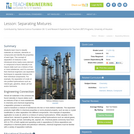
Students learn how to classify materials as mixtures, elements or compounds and identify the properties of each type. The concept of separation of mixtures is also introduced since nearly every element or compound is found naturally in an impure state such as a mixture of two or more substances, and it is common that chemical engineers use separation techniques to separate mixtures into their individual components. For example, the separation of crude oil into purified hydrocarbons such as natural gas, gasoline, diesel, jet fuel and/or lubricants.
- Subject:
- Applied Science
- Chemistry
- Engineering
- Physical Science
- Material Type:
- Lesson Plan
- Provider:
- TeachEngineering
- Provider Set:
- TeachEngineering
- Author:
- Parnia Mohammadi
- Roberto Dimaliwat
- Date Added:
- 09/18/2014
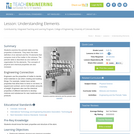
This lesson plan examines the properties of elements and the periodic table. Students learn the basic definition of an element and the 18 elements that build most of the matter in the universe. The periodic table is described as one method of organization for the elements. The concepts of physical and chemical properties are also reviewed.
- Subject:
- Applied Science
- Chemistry
- Engineering
- Physical Science
- Material Type:
- Activity/Lab
- Lesson Plan
- Provider:
- TeachEngineering
- Provider Set:
- TeachEngineering
- Author:
- Brian Kay
- Daria Kotys-Schwartz
- Janet Yowell
- Malinda Schaefer Zarske
- Date Added:
- 09/18/2014
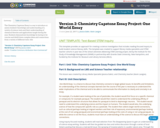
The Chemistry Capstone Essay is a way to introduce or assess students' knowledge and understanding of a variety of science texts and their understanding of chemical theories and applications taught during the year. Students demonstrate knowledge by having to be concise and distill down complex ideas and connections from a variety of different texts.
title
- Subject:
- Applied Science
- Physical Science
- Material Type:
- Assessment
- Lesson Plan
- Date Added:
- 09/27/2016